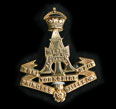 |
Remembrance
- The Yorkshire Regiment, First World War Private Gordon George HARFIELD. 9230 Close window to return to main page |
 |
No photo available, but biography provided. Close the window that opens to return to this page.
Private Gordon George HARFIELD, 9230.
2nd Battalion Yorkshire Regiment. Son of George and Ellen Harfield, of The
Railway Hotel, Norton, Malton, Yorks. Killed 17 October 1916. Aged 23.
Born Richmond (Yorks), Enlisted Richmond (Yorks).
Commemorated on Pier and Face 3A & 3D, THIEPVAL MEMORIAL.
John Sly (<sly211@btinternet.com>) has researched the career of Private
Harfield in connection with Private Harfield's medals. John has written a
short biography of Private Harfield.
Army Medal Office rolls confirm the award of the 1914 Star and Bar, giving his date of disembarkation as 5 October 1914 (WO 329/953 p 541, WO 329/2440 p 59).
He was born 9 February 1894 at The Barracks, Richmond, Yorkshire, the son of George Harfield, Sergeant, 1/Yorkshire Regiment, and his wife Ellen (nee Cole).
In 1901 he was living with his family at 10 Albert Place, Richmond. He was age seven, attending school, born Richmond, Yorkshire.
He attested 13 March 1908, age fourteen years. He was four feet ten and a half inches tall, and weighed ninety-three pounds. He had a fresh complexion, brown eyes, and brown hair. At the time of enlistment he was a schoolboy, born in Richmond and attested at Richmond. Remarks: ‘WO Letter’.
In 1911 he was with the battalion at the Infantry Barracks, Fulford Road, York; he was age seventeen, a Drummer, born Richmond, Yorkshire.
He was killed in action on 17 October 1916. A detailed account of the action is contained in the war diary for October 1916.
Wylly described the attack as follows:
‘On the 17th and 18th [October] the Division was engaged in an attack near the Le Transloy Ridges in the Gueudecourt area, the first task allotted to the 2nd Green Howards [sic] being the capture of a portion of Bayonet Trench, forming a defensive flank on the right, while at the same time a bombing party was to work up Bright Trench to its junction with Bayonet Trench. For the direct attack of Bayonet Trench three companies were detailed - D, C and A in that order from right to left - two platoons of B were to form the defensive flank, the remaining two assisting in the attack and supplying carrying parties if called upon. Half the Battalion bombers under Lieutenant R A Field, were to work up Bite Trench, the remainder moving with D Company and making a block in Bayonet Trench. The three attacking companies were to move in two lines, each company having two platoons in the front line and two in the second, the men moving at two paces interval with ten paces between the lines. During the evening of the 17th the companies were assembled in New Trench and in the front line to the right of it, and shortly before zero the men lay down in two lines, one along the tape which had previously been laid out, and other ten yards in rear of it. A Vickers Maxim Gun team, one of two allotted to the Battalion, got into position in rear of the right of C Company…The right and centre companies - D and C - had closed up until they consisted of groups of six or seven men each, somewhat irregularly spaced, from twenty to thirty yards from the German trench, and D only waited to charge forward till its rear line was nearer…Unhappily at this moment the left company - A - which had by this lost both its officers, and was under the fire of a machine gun on the left and also of rifles, wavered and fell back, and this movement unfortunately spread all down the line and could not be checked. Only two unwounded officers remained now with the attacking line, and thus the whole line fell back, the flanking parties conforming.’
The war diary recorded three reasons for the failure of the attack: exhaustion of the men, shortage of officers, and rifles being clogged by clay.
(Refs: WO 329/953 f 541; WO 329/2440 f 59
WO 95/2329
Regimental enlistment records, Richmond
General Register Office
The Green Howards In The Great War [Wylly] pp 80-81)